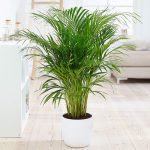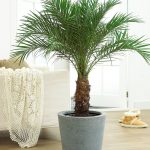14 of the Best Indoor Palm Trees for a Tropical Vibe
Published on February 8th 2020 by Rajib Banerjee under Green Living Ideas,Plants
If you want to transform your indoor space in a tone of vibrancy, decorating it with exotic lush green palm trees would be a good idea. Indoor palm plants come in different shapes, sizes, and species that offer an aesthetic look to the interiors. Take your pick from the big and small varieties of palm plants that help in generating positivity.
Small Indoor Palm Trees
1. European Fan Palm
As suggested by the name, these palms are native to Europe and western Mediterranean countries. It is also known as Mediterranean dwarf palm. It is quite hardy as compared to other palm varieties, tolerating extreme temperatures as low as 5oF. It has leaves in a unique fan-shaped pattern.
Height: From 5 feet up to 9 feet
Basic Care Requirement: The plant prefers to be in bright, filtered light.Water the palm daily during the spring and summer season while in winter, allow the top 2 inches of the soil to dry out between waterings.
Best Place To Keep: South and west-facing windows
2. Lady Palm
This attractive palm species is also known as Rhapis palm, and it is native to southeastern Asia, especially southern China and Taiwan. It is an evergreen fan palm forming a coarse cluster of skinny upright bamboo-like canes. The plant grows much slower than other palms. As this plant is a great air purifier it eliminates the most harmful pollutants from the air.
Height: 2 to 7 feet
Basic Care Requirement: You should keep it in a partially shaded spot. In spring and summer, you should water the plant only when the soil is dried out to a depth of an inch while in the fall and winter months, allow the soil to dry out to a depth of two inches.
Best Place To Keep: South and a west-facing windows
3. Cascade Palm
It is also known as the cat palm or Mexican hat palm and is local to Southern Mexico and Central America. This palm forms a cascading wall of lush, green, fern-like feathery leaves.
Height: Up to 6 feet
Basic Care Requirement: You need to place this palm in bright, filtered light. Watering should be done one to two times a week when the soil is turning to dry out.
Best Place To Keep: East-facing window (best side), west-facing window (between 1 to 3 feet away)
4. Chinese Fan Palm
Also known as the fountain palm, it has attractive, almost circular fan-shaped leaves. It is native to Australia, South China, Malay Peninsula, and New Guinea.
Height: 6 feet
Basic Care Requirement: This palm requires bright, filtered light, and you should avoid too shady spots, which may retard its growth.It needs very less amount of water, as it is quite a drought-resistant variety.
Best Place To Keep: North and south side windows
5. Pygmy Date Palm
This palm tree is also known as miniature date or dwarf date palm and is local to southeastern Asia. The attractive plant with arching leaves grows very slowly. The fronds or fern-like leaves grow from a central trunk. It is a great air purifier.
Height: 4 to 5 feet
Basic Care Requirement: You should keep this plant in filtered light or partially shaded condition. You need to water the palm once in every 2 to 3 days during spring and summer season, but check the soil to dry out to a depth of 2 inches before watering. In fall and winter months, reduce the watering session to every 15 days. Occasional misting with water should be done.
Best Place To Keep: South and west-facing windows
6. Parlor Palm
It is amongst one of the most favored palms and is native to Southern Mexico and Guatemala. This plant is often known as tuna tail palm, metallic palm, miniature fishtail palm, or velvet palm. Parlor palm is a slow-growing variety, taking years to reach the mature height.
Height: 3 to 4 feet
Basic Care Requirement: As the palm thrives in low-light conditions, keep it in the shaded areas of your home. During the propagating months of spring and summer, you should water it once in a week. However, in the fall and winter seasons, as the plant remains dormant and slows its growth rate, water it once every couple of weeks.
Best Place To Keep: East and west sides
7. Majesty Palm
This is also known as majestic palm and is native to Madagascar. The plant requires moisture and grows well in warm and humid temperatures.
Height: 5 feet
Basic Care Requirement: You should provide this palm tree bright, filtered light of around 4 to 6 hours daily. Also, you need to provide water 1 to 2 times a week, letting the top 2 inches of soil to dry out in between waterings.
Best Place To Keep: East-facing window
8. Ruffled Fan Palm
This palm is native to Vanuata Islands in South Pacific. The slow-growing variety has heavily wrinkled leaves giving it a stunning ruffled or pleated design. Its trunk is slim and covered with fiber.
Height: 6 feet
Basic Care Requirement: As this plant prefers shade, you should place it in partial to full shaded spots. In summer months, allow the soil to dry out before re-watering. While, in winter, as the growth rate slows down, give it even less water.
Best Place To Keep: You can keep it anywhere in the room, but away from the windows to protect it from the winds, which can damage its leaves.
Tall Indoor Palm Plants
9. Areca Palm
Commonly known as the butterfly palm or the golden cane palm, this is the most famous cane-type palm, native to Madagascar and South India. It grows at a rate of around 6-10 inches every year. It generates attractive feathery fern-like leaves portraying a natural décor to our interiors. It is safe for kids and pets like cats. This large indoor palm is among the top air-purifying plants and is also the most efficient air humidifier.
Height: 8 feet
Basic Care Requirement: You should keep it in bright filtered light; however, it tolerates low light conditions. During spring and summer, you should maintain slightly moist soil and provide distilled water instead of tap water, as this plant is sensitive to fluoride. In fall and winter, the care instruction is to allow the soil to dry out in between the watering sessions. Do not overwater the plant, or else the roots will decay.
Best Place To Keep: West and southeast sides
10. Bamboo Palm
Native to Mexico and Central America, this plant is also known as the reed palm and acquires the name from the long bamboo-like canes. These palms are ideal for growing as houseplants, as it is slow-growing. However, the plant grows to a larger size when exposed to lots of bright light. But, if kept in some shady spot, the growth can be controlled. It helps to provide a healthy dose of moisture, apart from cleaning the air.
Height: 4 to 12 feet
Basic Care Requirement: You should keep it in partial sun to fully shaded areas. Avoid overwatering and also allow the soil to dry out in between watering sessions. Mist it occasionally with water for some extra amount of humidity.
Best Place To Keep: Southeast side, near the windows
11. Fishtail Palm
As the name indicates, the leaves of this palm are similar to a fishtail. This fast-growing plant is native to the Asian countries of India, China, Indonesia, the South Pacific region and northern Australia, adapting to warm tropical Mediterranean temperatures. It is a drought-resistant variety and survives high-temperature conditions.
Height: 10 feet
Basic Care Requirement: Provide it with bright, filtered light.It is advisable to give a regular supply of water with proper drainage facility, but avoid overwatering to prevent the roots from decaying. Occasional misting of water is required.
Best Place To Keep: Southeast and west side windows
12. Kentia Palm
Local to Eastern Australian coast, this attractive palm tree is also known as paradise palm. It provides an exotic and tropical feel to your home. It is more of a slow-growing palm variety, tolerating low temperatures. It is safe for pets like cats.
Height: 5 to 12 feet
Basic Care Requirement: It tolerates low light conditions, and grows well, compared to other palm species. This plant requires slightly moist soil. Water only when 1 to 2 inches of the topsoil is beginning to dry out. Further, you should maintain a well-drained pot to avert any root decay due to water clogging. The plant can be misted with water to maintain the humidity level.
Best Place To Keep: East, west and south-facing windows
13. Canary Island Date Palm
This palm variety is similar to the pygmy date palm and is the native plant species of the Canary Islands. The plant has a strong trunk with deep green leaves divided into many leaflets in a straight line.
Height: 10 feet
Basic Care Requirement: You should keep this plant in partially-shaded areas. Refrain from overwatering the plant, and allow the pot to have a proper draining hole. Further, you should let the 2 inches of the topsoil to dry out, before the re-watering session. Thus, water should be given every week to assist the palm to grow with deep roots.
Best Place To Keep: East and a west-facing windows
14. Sentry Palm
This palm plant is native to Lord Howe Island in Australia and is also called the curly palm. It is a slow-growing variety. Apart from purifying the air, it acts as a natural humidifier. It is not poisonous to pets like cats and dogs. Humid conditions are preferable for this plant, which is similar to its natural habitat.
Height: 10 feet
Basic Care Requirement: You should provide it low, filtered light. Water it only when the 1 to 2 inches of the topsoil is beginning to dry out.
Best Place To Keep: South-facing window
Palm-Like Plants
There are a few plants that resemble palms in their looks and are commonly grown indoors, as indicated below.
- Sago palm
- Ponytail palm
- Yucca plant
- Banana palm
- Bird of paradise
There are scores of palm species available in nature, but only some of them are suited to grow indoors. All of these popular varieties prefer to be in nutrient-rich, and well-draining soil. To enhance the overall growth rate and longevity of these plants, you should engage in pruning and trimming activities, and occasionally apply the requisite fertilizers. Thus, you can replicate the natural habitat to enhance the interiors of your home with captivating greenery of these exceptional palm trees showcasing an impressive display of foliage.
Popular
 DIY: Healthy Homemade Cat Food Recipes
DIY: Healthy Homemade Cat Food Recipes
Give occasional treats to your loving pet cat with the best nutritious homemade dishes, rather […]
 How to Lighten Hair Naturally
How to Lighten Hair Naturally
Best homemade recipes for making your own natural hair lighteners! Try making your own hair […]
 9 Best Homemade Natural Mouthwash Recipes
9 Best Homemade Natural Mouthwash Recipes
Smile more; talk more to your friends confidently trying these mouthwash recipes! Bad breath is […]
Prepare your own tooth powder at home for healthy gums and teeth. The recipes given […]
As the name suggests, wool dryer balls serve the same purpose as plastic PVC or […]





















